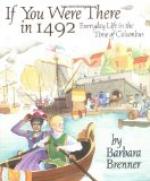A “horrible carnage” ensued upon the flight of the Indians. Many of them, less fortunate, perhaps, than those who were slain, being taken alive, were condemned to slavery. Caonabo, however, who was besieging the fortress of St. Thomas at the time of the battle on the Vega Real, remained untaken. The admiral resolved to secure the person of this cacique by treachery; and sent Ojeda (who afterwards became a conspicuous actor in the sad drama of conquest and depopulation in the West Indies) to cajole Caonabo into coming to a friendly meeting. There are some curious instructions of Columbus’s to Margarite in 1494, respecting a plot to take this formidable Caonabo. They are as thoroughly base and treacherous as can well be imagined. This time the admiral’s plan was completely successful.
Cunning capture of Indian chief.
The story which was current in the colonies, of the manner in which Ojeda captured the resolute Indian chief, is this. Ojeda carried with him gyves and manacles, the latter of the kind called by the Spaniards, somewhat satirically, esposas (wives), and all made of brass or steel, finely wrought, and highly polished. The metals of Spain were prized by the Indians in the same way that the gold of the Indies was by the Spaniards. Moreover, amongst the Indians, there was a strange rumour of talking brass, that arose from their listening to the church bell at Isabella, which, summoning the Spaniards to mass, was thought by the simple Indians to converse with them. Indeed the natives of Hispaniola held the Spanish metals in such estimation that they applied to them an Indian word, Turey, which seems to have signified anything that descends from heaven. When, therefore, Ojeda brought these ornaments to Caonabo, and told him they were Biscayan Turey, and that they were a great present from the admiral, and that he would show him how to put them on, and that when they were put on Caonabo should set himself on Ojeda’s horse and be shown to his admiring subjects, as, Ojeda said, the kings of Spain were wont to show themselves to theirs, the incautious Indian is said to have fallen entirely into the trap. Going with Ojeda, accompanied by only a small escort, to a river a short distance from his main encampment. Caonabo, after performing ablutions, suffered the crafty young Spaniard to put the heaven-descended fetters on him, and to set him upon the horse. Ojeda himself got up behind the Indian prince, and then whirling a few times round, like a pigeon before it takes its determined flight, making the followers of Caonabo imagine that this was but display, (they all the while keeping at a respectful distance from the horse, an animal they much dreaded,) he darted off for Isabella, and after great fatigues, now keeping to the main track, now traversing the woods in order to evade pursuit, brought Caonabo bound into the presence of Columbus. The unfortunate cacique was afterwards sent to Spain [He died on the voyage, however.] to be judged there; and his forces were presently put to flight by a troop of Spaniards under the command of this same Ojeda. Some were killed; some taken prisoners; some fled to the forests and the mountains; some yielded, “offering themselves to the service of the Christians, if they would allow them to live in their own ways.”




